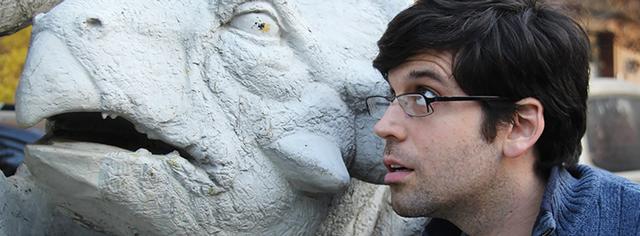On a family trip when I was three years old, I received a plastic toy of a duckbilled dinosaur in a fast food kid’s meal. Since that time, I have been fascinated by the amazing variety of anatomies that existed in reptiles in the prehistoric past. I especially love placing those fossil species in the context of evolutionary trees, which can show us how anatomies changed over time and the diversity of different species waxed and waned. The fossil record is the greatest tool we have to understand the true diversity of organisms throughout Earth’s history. I am grateful for the opportunity to help tell the stories of Virginia’s fossil record as the Assistant Curator of Paleontology.
- Dr. Adam Pritchard on what inspired him to pursue a career in science
Contact
Dr. Adam Pritchard
Assistant Curator of Paleontology
adam.pritchard@vmnh.virginia.gov
Professional Titles
- Assistant Curator of Paleontology, Virginia Museum of Natural History
Education
- Ph.D. Anatomical Sciences, Stony Brook University, 2015
- B.A. Biology, McDaniel College, 2009
Professional Experience
- Peter Buck Postdoctoral Fellow, Smithsonian Institution, National Museum of Natural History,
2017–2019 - NSF Postdoctoral Fellow, Yale University, 2015–2017
- Research Assistant, Stony Brook University, 2009–2014
Teaching Assistant, Stony Brook University, 2010
Research Interests
- Comparative anatomy and phylogeny of Permo-Triassic Diapsida, with a focus on small-bodied
taxa - Evolution of early Mesozoic vertebrate faunas in North America
- Comparative anatomy and phylogeny of Crocodylomorpha
- CT imaging and its use for reconstructing three-dimensional morphology in fossil and modern
vertebrates
Publications
- Pritchard, A.C., H.-D. Sues, D. Scott, and R. R. Reisz. in revision. Osteology, relationships, and
functional morphology of Weigeltisaurus jaekeli (Diapsida, Weigeltisauridae) based on a
complete skeleton from the Upper Permian Kupferschiefer of Germany. PeerJ. - Jenkins, X. A., A. C. Pritchard, A. D. Marsh, B. T. Kligman, C. A. Sidor, and K. E. Reed. in press.
Using manual ungual morphology to predict substrate use in the Drepanosauromorpha and the
description of a new species. Journal of Vertebrate Paleontology. - Formoso, K. K., S. J. Nesbitt, A. C. Pritchard, M. R. Stocker, and W. G. Parker. 2019. A long-
necked tanystropheid from the Middle Triassic Moenkopi Formation (Anisian) provides insights
into the ecology and biogeography of tanystropheids. Paleontologia Electronica 22.3.73:1–15. - Pritchard, A.C., and H.-D. Sues. 2019. Postcrania of Teraterpeton hrynewichorum (Reptilia,
Archosauromorpha) and the mosaic evolution of the saurian postcranial skeleton. Journal of
Systematic Palaeontology DOI:10.1080/14772019.2018.1551249. - Pritchard, A. C., J. A. Gauthier, M. Hanson, and B.-A. S. Bhullar. 2018. A tiny Triassic saurian
from Connecticut and the early evolution of the diapsid feeding apparatus. Nature
Communications 9 DOI:10.1038/s41467-018-03508-1. - Pritchard, A.C., and S. J. Nesbitt. 2017. A bird-like skull in a Triassic diapsid reptile increases
heterogeneity of the morphological and phylogenetic radiation of Diapsida. Royal Society Open
Science 4:170499. DOI:10.1098/rsos.170499. - Fabbri, M., N.M. Koch, A. C. Pritchard, M. Hanson, E. Hoffman, G.S. Bever, A.M. Balanoff, Z.S.
Morris, D.J. Field, J. Camacho, T.B. Rowe, M.A. Norell, R.M. Smith, A. Abzhanov, and B.-A. - Bhullar. 2017. The skull roof tracks the regions of the brain evolutionarily and ontogenetically in
the deep history of Archosauria. Nature Ecology & Evolution DOI:10.1038/s41559-017-0288-2. - Turner, A. H., A.C. Pritchard, and N.J. Matzke. 2017. Empirical and Bayesian approaches to
fossil-only divergence times: A study across three reptile clades. PLoS One
DOI:10.1371/journal.pone.0169885. - Pritchard, A.C., A. H. Turner, R. B. Irmis, S. J. Nesbitt, and N. D. Smith. 2016. Extreme
modification of the tetrapod forelimb in a Triassic reptile. Current Biology 26:2779–2786. - Bhullar, B.-A., M. Hanson, M. Fabbri, A. C. Pritchard, G. S. Bever, and E. Hoffman. 2016. How
to make a bird skull: major transitions in the evolution of the avian cranium, paedomorphosis,
kinesis, and the beak as a surrogate hand. Integrative and Comparative Biology
DOI:10.1093/icb/icw069. - Nesbitt, S. J., J. J. Flynn, A. C. Pritchard, J. M. Parrish, L. Ranivoharimanana, A. R. Wyss.
2015. Postcranial osteology of Azendohsaurus madagaskarensis (Triassic Isalo Group of
Madagascar) and its systematic position among archosauromorphs. Bulletin of the American
Museum of Natural History 398:1–126. - Turner, A. H. and A. C. Pritchard. 2015. Observations on the morphology of Isisfordia duncani
and its phylogenetic placement in Neosuchia. PeerJ 3:e759. - Pritchard, A. C., A. H. Turner, S. J. Nesbitt, R. B. Irmis, and N. D. Smith. 2015. Late Triassic
tanystropheid (Reptilia: Archosauromorpha) remains from northern New Mexico (Petrified
Forest Member, Chinle Formation): insights into their distribution, morphology, and
paleoecology. Journal of Vertebrate Paleontology 35:e911186. - Pritchard, A. C., J. A. McCartney, D. W. Krause, and N. J. Kley. 2014. New snakes from the
Upper Cretaceous Maevarano Formation, Mahajanga Basin, Madagascar. Journal of Vertebrate
Paleontology 34:1080–1093. - Pritchard, A. C., A. H. Turner, E. R. Allen, and M. A. Norell. 2013. Osteology of a North
American goniopholidid (Eutretauranosuchus delfsi) and palate evolution in Neosuchia.
American Museum Novitates 3783:1–56.

 Hours & Admissions
Hours & Admissions Directions
Directions

